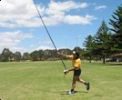- News
- Updates to this website are all listed in What's New or use Search
Herring are a very important recreational fish on the west and south coasts of Western Australia.
This page gives some tips on fishing for herring from the shore. Many of the tips will also work when fishing from boats.
Herring are great fish to catch on light gear such as a small single handed rod and 2 or 3kg line. They are speedy, acrobatic and strong, often jumping out of the water when hooked.
Australian Herring (Arripis georgianus) and juvenile Australian Salmon (Arripis truttaceus) in Western Australia are similar in appearance and often confused. That's not surprising, since they are related species. Both species have rows of golden or brown spots on their sides and back.
Keeping undersized Australian salmon which have been mistaken for herring can lead to penalties, so check carefully.

Australian Herring. Note the large eye
Herring have a large yellow and black eye, black tips to the tail fins, clear pectoral fins, and rough scales.
Herring minimum size limit: none.
Herring bag limit: 12 herring per day within the combined overall 30 fish per day bag limit in the "All other species" category State wide in Western Australia.
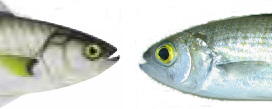
Compare: juvenile Australian Salmon (left)
adult Australian Herring (right)
Juvenile Australian salmon are very similar and are sometimes confused with herring, but have a smaller eye, no black tips on the tail, pectoral fins tending to be yellow, and smooth scales.
Salmon minimum size limit: 300mm.
Salmon bag limit: 4 salmon per day within the combined overall 16 fish per day bag limit of "Nearshore/estuarine finfish" category State wide in Western Australia.
Where: Herring can be found everywhere on the lower west and south coasts of Western Australia, in estuaries, near reefs, reef holes, beaches, rock walls, and jetties. Herring are easily attracted with berley.
When: Herring can bite well at any time of the day or night. Early morning is sometimes better, because the bites can taper off if they are fed with too much berley. But like all fish, sometimes they are just not very interested in feeding. Then you might need to tempt them with the right type and size of bait or lure.
Seasons: Years ago, herring were a seasonal fish on the West Coast, with autumn and winter the best times and much fewer fish in late spring and summer. In recent years, herring can be caught all year round if you know how to fish for them.
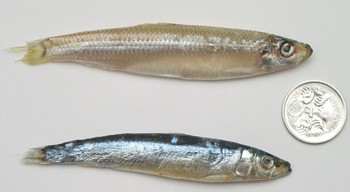
"Whitebait" (top) and "bluebait" (bottom)
Excellent baits for herring and lots of other species
5c coin is 19mm or 3/4 inch diameter
Baits: Maggots (sometimes called "wogs"), whitebait, bluebait, pieces of mulie (pilchard) or other fish, squid, octopus, prawn, shellfish, crab, red meat, chicken, any of the artificial baits cut to a suitable size.
Lures: Herring really love small chrome or gold lures, small soft plastic or hard bodied lures, flashy flies, flouro green or white tubing and even a piece of silver or coloured foil. Vary the speed of retrieve, because if a herring really wants your lure, you can't wind fast enough to pull it out of its mouth, and they can zip through the water at amazing speeds.
Herring are expert at throwing off weighted metal lures when they jump out of the water. If you land one in five hook ups with a weighted lure, you're doing well. The good thing is, often there's a queue of other herring after that lure.
Berley: Pollard, fish oil, minced up fish scraps, mashed up mulies, tinned sardines, etc. Use little and often. Herring will come right to your feet in 30 cm or less of water. Cast shorter each time and bring them closer to you. Throw a little berley close in. You'll see the herring darting around and making splashes on the surface as they take the berley.
Bite: Herring often bite hard and hook themselves, particularly when you are moving the bait. At other times they are fussier. In calm conditions, one way is to just watch the line and you'll see the bites or see the line tighten. Just tighten the line without jerking and you'll feel the weight of the fish.
Hooks: For whitebait or bluebait: a gang of three Limerick or Tarpon size 6 to 2 depending on the size of bait. Make sure they are sharp. For other baits size 8 to 4 Beak, Suicide, wide gap or similar hook type. If herring are fussy, go to smaller hooks and smaller baits.
Traces: (The line between the weight and the hook) Herring sometimes refuse to bite on short and heavy traces. Use 2 to 3 kg line, 1 to 2 metres long behind a berley cage or blob. Sure, it might wear and you might snap it, but you will get a lot more bites, and there's the bonus of garfish if they are around.
Weights: Use the smallest and lightest weight sinker you can cast or will take the bait down to the fish. Berley herring in close and try using no weight at all. Sometimes a cast of 3 metres is enough.
Blobs: (Floats) Solid or with a hole for berley. Use a heavy trace through the blob to avoid break offs, tied to rings or swivels.
Berley cages: Sinking or floating, wire or plastic.

Berley blob (float) and bait or lure rig

Berley cage and bait rig

"Double whitebait or bluebait" rig. Adapt them for the bait you're using. Have several of
these ready made, and pick the sinker style and hooks to suit the bait and where you
are fishing. Catches many other species too!!
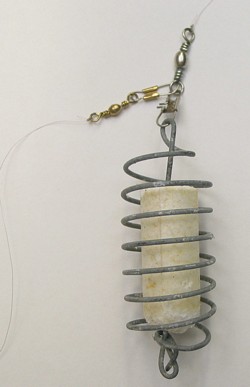
One way of rigging a slow sinking berley
cage. Main line to the top, bait trace to
the left
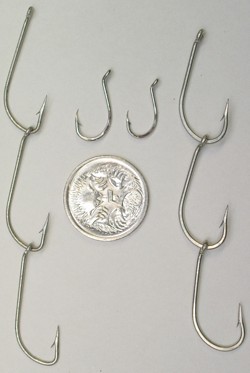
Ganged hooks "Limerick" type on left,
stronger "Tarpon" on right,
for whitebait or bluebait,
"suicide" or "beak" hooks for bait in centre.
5c coin is 19mm = 3/4 inch diameter

Rigging a blob (float), main line to the left, bait to the right. The bead protects the
knot from damage and break offs after repeated casting
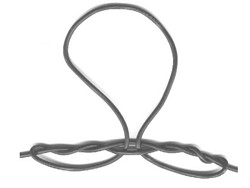
Knot for dropper loops
Dropper loop knot. Wet the dropper knot well and pull the loop and lines slowly and evenly until the knot is tight. Use more turns for light line.
The loop can be cut and then the dropper will stand out from the main line.
This knot introduces a slightly weaker point in the line, so use suitable breaking strain line if casting a heavy sinker.
1. Fine, light, long traces put the bait or lure away from the blob or burley cage and will get many more bites compared to using shorter or heavier traces. Use clear nylon or even fluorocarbon leaders when they are really fussy.
2. A small hook well hidden in a small bait wafting around in the berley on a very light trace will often get snapped up when bigger baits are rejected.
3. The "secret" of using whitebait and bluebait without them going mushy and falling off the hooks are: make sure they are fresh, and add a handful of dry pollard after they have thawed, and dip in fish oil for extra smell.
4. Use berley, but don't overdo it. Use just enough to keep them interested and searching for more but not fed. Bring the fish close to you.
5. There are many ways to catch herring, but sometimes they are fussy. If someone else is catching herring but you are not, check the rig, bait and fishing technique they are using, and do the same.
And when you have caught your fish, make sure you look after them properly to get the best out of these delicious small fish.
Herring frequently asked questions
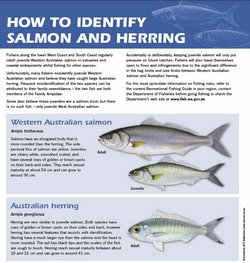
Brochure: How to identify herring and
juvenile salmon
(PDF file, link opens in a new window)
Come to some Club events as a visitor, to our monthly dry casting mornings, fishing trips or general meetings. Read more
Come to a Club event to meet us and make sure you are happy ith how the club suits your needs, then fill out and send us the membership application form. Read more

